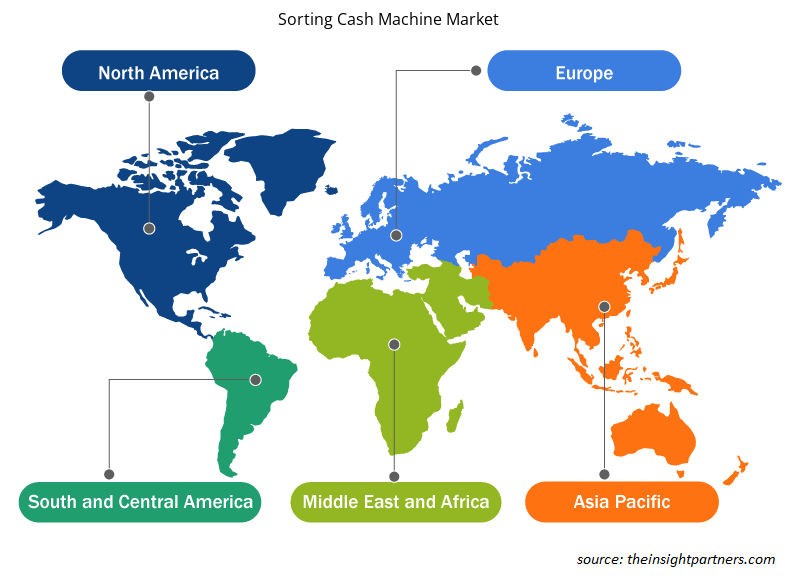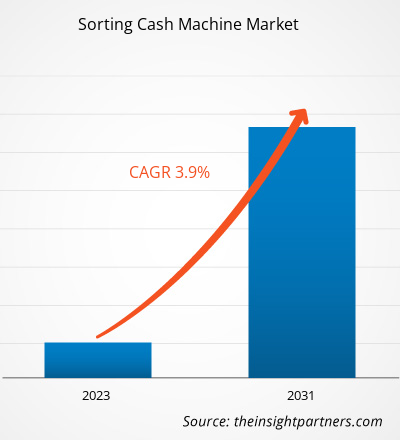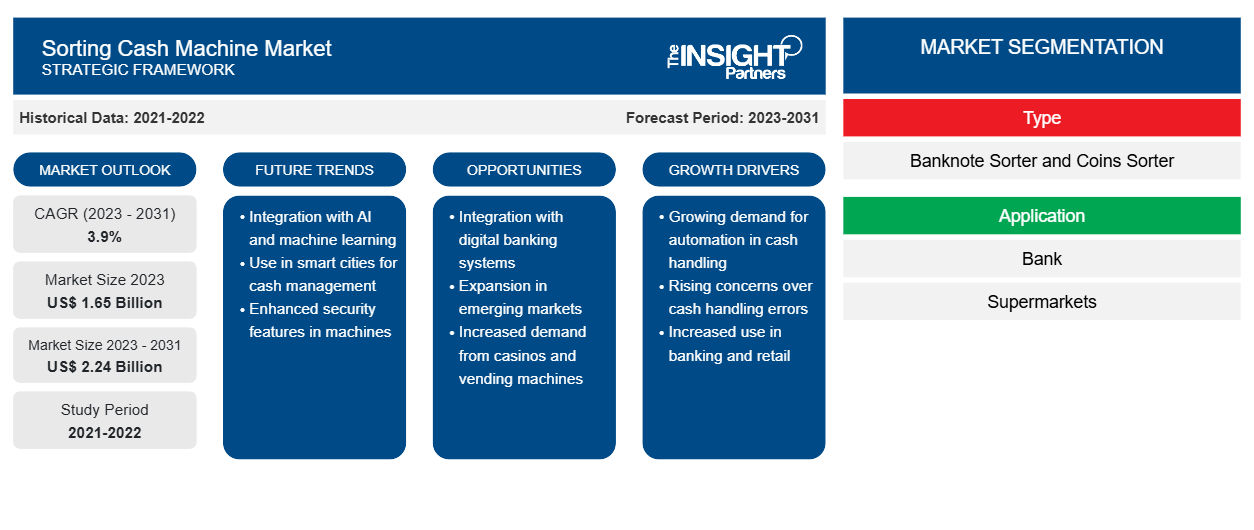Der Markt für Geldsortierautomaten soll von 1,65 Milliarden US-Dollar im Jahr 2023 auf 2,24 Milliarden US-Dollar im Jahr 2031 wachsen; von 2023 bis 2031 wird eine durchschnittliche jährliche Wachstumsrate von 3,9 % erwartet. Produkttechnologische Entwicklungen und ungenutztes Marktpotenzial in Schwellenländern dürften den Markt für Geldsortierautomaten in naher Zukunft ankurbeln. Die Verwendung dieser Automaten bringt weitere Verhaltensvorteile mit sich, wie weniger Fehler beim Sortieren und Zählen, geringere Betriebskosten, weniger finanzielle Verluste und weniger interne Gefahren im Zusammenhang mit dem Zählen und Sortieren.
Marktanalyse für Geldsortierautomaten
Geldsortierautomaten werden in vielen bargeldintensiven Unternehmen und Finanzorganisationen eingesetzt, darunter Einzelhandelsgeschäfte, Casinos, Geschäftsbanken und mehr. Einige Weiterentwicklungen bei Geldsortierautomaten, wie z. B. die gewichtsbasierte Geldsortierung, machen den Einsatz moderner Systeme praktikabler. Der Markt wird durch den unkontrollierten und nicht unterbrochenen Geldfluss durch Banken, Casinos und andere Finanzinstitute angetrieben. Der regelmäßige Umlauf von Bargeld in großen Mengen von einer Branche zur anderen ist ein wichtiger Grund für die Nachfrage nach Geldsortiergeräten.
Marktübersicht für Geldsortierautomaten
- Bargeld, wie Münzen und Banknoten, kann mithilfe eines Geldsortierautomaten sortiert werden. Das Gerät durchläuft einen Stapel Münzen oder Scheine und sortiert sie nach ihren verschiedenen Nennwerten. Zusätzlich wird das Geld gezählt und nach vorgegebenen Mengen in andere Kategorien unterteilt. Mithilfe bestimmter Sicherheitsmaßnahmen können einige hochentwickelte Geldsortierautomaten auch dabei helfen, gefälschte Münzen oder Scheine zu identifizieren. Da ständig viel Bargeld gesammelt wird, werden Geldsortierautomaten in Banken, Kasinos, Finanzinstituten, Krankenhäusern, Supermärkten und großen Freizeitparks eingesetzt.
- Das Sortieren von Geldautomaten verringert den Arbeitsaufwand beim Sortieren von Bargeld und spart viel Zeit, die sonst mit dem Sortieren und Zählen von Banknoten verbracht werden müsste. Dies verringert auch die Fehlerwahrscheinlichkeit, die beim manuellen Sortieren und Zählen von Bargeld auftreten. Dies führt auch zu geringeren finanziellen Verlusten und niedrigeren Betriebskosten. Wenn ein Bündel Banknoten eingeführt wird, beginnen die Geldautomaten sofort mit dem Sortieren und Zählen der Banknoten und liefern genaue Ergebnisse. Die Erkennung gefälschter Banknoten und Münzen trägt zum Schutz des Rufs des Unternehmens bei. Der Automat erkennt auch fehlerhafte Banknoten und beginnt zu piepen, wenn er solche Banknoten oder Münzen findet.
Passen Sie diesen Bericht Ihren Anforderungen an
Sie erhalten kostenlose Anpassungen an jedem Bericht, einschließlich Teilen dieses Berichts oder einer Analyse auf Länderebene, eines Excel-Datenpakets sowie tolle Angebote und Rabatte für Start-ups und Universitäten.
-
Holen Sie sich die wichtigsten Markttrends aus diesem Bericht.Dieses KOSTENLOSE Beispiel umfasst eine Datenanalyse von Markttrends bis hin zu Schätzungen und Prognosen.
Markttreiber und Chancen für Geldsortierautomaten
Technologische Fortschritte bei Geldsortiermaschinen treiben den Markt für Geldsortiermaschinen voran
- Technologische Entwicklungen tragen zum Wachstum des Marktes für Geldsortierautomaten bei. Die Geldsortierautomatenbranche wird durch viele Entwicklungen bei Geldsortiermaschinen vorangetrieben, wie z. B. die gewichtsbasierte Geldsortierung, die eine verbesserte Verwendung von Bargeld ermöglicht.
- Moderne Maschinen legen den Schwerpunkt auf Effizienz, was Zeit spart und die Betriebseffizienz eines Unternehmens steigert. Die europäische Regierung regelt die Verwendung von Münzsortiermaschinen gemäß der Verordnung (EU) Nr. 1210/2010, um Geldfälschungen vorzubeugen und Bargeldzähl- und -sortiervorgänge zu validieren. Um für den Vertrieb von Geldsortiergeräten auf dem europäischen Markt zugelassen zu werden, müssen die Hersteller die in den Richtlinien der Kommission festgelegten Akzeptanzanforderungen erfüllen.
Sensibilisierung für Bargeldfälschung zur Schaffung lukrativer Marktchancen
- Marktteilnehmer entwickeln Geldsortiermaschinen mit ausreichenden Sicherheitsvorkehrungen, um Geldfälschungen zu verhindern. Dazu werden Technologien der nächsten Generation eingesetzt. Die Hersteller streben danach, ihre Marktposition zu festigen, indem sie diese Geräte mit zuverlässigen Algorithmen und Technologien zur Gelderkennung ausstatten.
- Während Sicherheit, Genauigkeit und Effizienz noch immer die wichtigsten Eigenschaften von Geldsortiermaschinen sind, integrieren die Hersteller zunehmend programmierbare Touchscreen-Displays, Maschinengrafiken und die berührungslose Handhabung von Bargeld.
- Um sich einen Wettbewerbsvorteil zu verschaffen, nutzen Hersteller und Händler fortschrittliche Technologien, um einzigartige und hochwertige Sicherheitsmaßnahmen in Geldsortiermaschinen einzubauen. Der Markt für Geldsortiermaschinen dürfte im Prognosezeitraum aufgrund verschiedener Marktmerkmale, darunter der sinkenden Bargeldnutzung, moderat wachsen.
Marktbericht zum Sortieren von Geldautomaten – Segmentierungsanalyse
Das Schlüsselsegment, das zur Ableitung der Marktanalyse für Geldsortierautomaten beigetragen hat, ist der Typ.
- Der Markt ist nach Typ in Banknotensortierer und Münzsortierer unterteilt. Die Kategorie der Geldautomaten zur Banknotensortierung hat den größten Marktanteil, da sie die Bargeldverwaltung durch ordnungsgemäßes Sortieren und Verpacken von Banknoten verbessern kann, was zu höherer Produktivität, Effizienz und Sicherheit führt.
- Basierend auf der Anwendung wird der Markt in drei Bereiche unterteilt: Banken, Supermärkte und andere. Das Bankensegment wird sich voraussichtlich am schnellsten entwickeln, da digitale Zahlungen weit verbreitet sind, die Präsenz von Finanzinstituten und Banken zunimmt und es technologische Fortschritte bei Banksortiermaschinen gibt.
Marktanteilsanalyse für Geldsortierautomaten nach geografischer Lage
- Der Markt für Geldsortierautomaten ist hauptsächlich in fünf Regionen unterteilt: Nordamerika, Europa, Asien-Pazifik, Naher Osten und Afrika sowie Südamerika. Die Region Asien-Pazifik wird im Prognosezeitraum voraussichtlich die höchste durchschnittliche jährliche Wachstumsrate aufweisen.
- Der zunehmende Einsatz der Bargeldautomatisierung, der durch das Aufkommen digitaler Zahlungen vorangetrieben wird, unterstützt das Wachstum des Marktes für Geldsortiermaschinen im Asien-Pazifik-Raum, da Unternehmen und Finanzinstitute versuchen, die Effizienz und Genauigkeit bei Bargeldtransaktionen mit hohem Volumen mithilfe dieser Maschinen zu erhöhen.
Darüber hinaus wird für den Markt ein Wachstum aufgrund steigender verfügbarer Einkommen, technologischer Entwicklungen bei Geldsortiermaschinen, erhöhter Nachfrage nach Geldsortiermaschinen in Finanzinstituten und wachsender Nachfrage aus verschiedenen Endverbrauchsbranchen erwartet.
Regionale Einblicke in den Markt für Geldautomaten zum Sortieren
Die regionalen Trends und Faktoren, die den Markt für Geldsortierautomaten im Prognosezeitraum beeinflussen, wurden von den Analysten von Insight Partners ausführlich erläutert. In diesem Abschnitt werden auch die Marktsegmente und die Geografie von Geldsortierautomaten in Nordamerika, Europa, im asiatisch-pazifischen Raum, im Nahen Osten und Afrika sowie in Süd- und Mittelamerika erörtert.

- Erhalten Sie regionale Daten zum Markt für Geldautomaten zum Sortieren
Umfang des Marktberichts über Geldautomaten zum Sortieren
| Berichtsattribut | Details |
|---|---|
| Marktgröße im Jahr 2023 | 1,65 Milliarden US-Dollar |
| Marktgröße bis 2031 | 2,24 Milliarden US-Dollar |
| Globale CAGR (2023 - 2031) | 3,9 % |
| Historische Daten | 2021-2022 |
| Prognosezeitraum | 2023–2031 |
| Abgedeckte Segmente |
Nach Typ
|
| Abgedeckte Regionen und Länder |
Nordamerika
|
| Marktführer und wichtige Unternehmensprofile |
|
Dichte der Marktteilnehmer für Geldautomaten: Auswirkungen auf die Geschäftsdynamik verstehen
Der Markt für Geldsortierautomaten wächst rasant, angetrieben durch die steigende Nachfrage der Endnutzer aufgrund von Faktoren wie sich entwickelnden Verbraucherpräferenzen, technologischen Fortschritten und einem größeren Bewusstsein für die Vorteile des Produkts. Mit steigender Nachfrage erweitern Unternehmen ihr Angebot, entwickeln Innovationen, um die Bedürfnisse der Verbraucher zu erfüllen, und nutzen neue Trends, was das Marktwachstum weiter ankurbelt.
Die Marktteilnehmerdichte bezieht sich auf die Verteilung der Firmen oder Unternehmen, die in einem bestimmten Markt oder einer bestimmten Branche tätig sind. Sie gibt an, wie viele Wettbewerber (Marktteilnehmer) in einem bestimmten Marktraum im Verhältnis zu seiner Größe oder seinem gesamten Marktwert präsent sind.
Die wichtigsten Unternehmen auf dem Markt für Geldsortierautomaten sind:
- Bcash, Elektronikunternehmen
- Cummins Allison
- De La Rue plc
- Giesecke+Devrient GmbH
- Glory Global Solutions (International) Limited
Haftungsausschluss : Die oben aufgeführten Unternehmen sind nicht in einer bestimmten Reihenfolge aufgeführt.

- Überblick über die wichtigsten Akteure auf dem Markt für Geldsortierautomaten
Nachrichten und aktuelle Entwicklungen zum Markt für Geldautomatensortierung
Unternehmen verfolgen auf dem Markt für Geldsortierautomaten anorganische und organische Strategien wie Fusionen und Übernahmen. Einige der jüngsten wichtigen Marktentwicklungen sind unten aufgeführt:
- 2022 forderte die Reserve Bank of India (RBI) die Banken auf, ihre Banknotensortiermaschinen vierteljährlich auf Konsistenz und Genauigkeit zu testen, um sicherzustellen, dass die Banknoten den vorgeschriebenen Parametern entsprechen. [Quelle: Pressemitteilung]
Marktbericht zum Geldsortierautomaten – Umfang und Ergebnisse
Die Marktprognose für Geldsortierautomaten wird auf der Grundlage verschiedener sekundärer und primärer Forschungsergebnisse geschätzt, wie z. B. wichtiger Unternehmenspublikationen, Verbandsdaten und Datenbanken. Der Marktbericht „Marktgröße und Prognose für Geldsortierautomaten (2021–2031)“ bietet eine detaillierte Analyse des Marktes, die die folgenden Bereiche abdeckt:
- Marktgröße und -prognose auf globaler, regionaler und Länderebene für alle abgedeckten wichtigen Marktsegmente.
- Marktdynamik wie Treiber, Beschränkungen und wichtige Chancen.
- Wichtige Zukunftstrends.
- Detaillierte PEST- und SWOT-Analyse
- Globale und regionale Marktanalyse, die wichtige Markttrends, wichtige Akteure, Vorschriften und aktuelle Marktentwicklungen abdeckt.
- Branchenlandschaft und Wettbewerbsanalyse, einschließlich Marktkonzentration, Heatmap-Analyse, Schlüsselakteuren und aktuellen Entwicklungen.
- Detaillierte Firmenprofile.
- Historische Analyse (2 Jahre), Basisjahr, Prognose (7 Jahre) mit CAGR
- PEST- und SWOT-Analyse
- Marktgröße Wert/Volumen – Global, Regional, Land
- Branchen- und Wettbewerbslandschaft
- Excel-Datensatz
Aktuelle Berichte
Verwandte Berichte
Erfahrungsberichte
Grund zum Kauf
- Fundierte Entscheidungsfindung
- Marktdynamik verstehen
- Wettbewerbsanalyse
- Kundeneinblicke
- Marktprognosen
- Risikominimierung
- Strategische Planung
- Investitionsbegründung
- Identifizierung neuer Märkte
- Verbesserung von Marketingstrategien
- Steigerung der Betriebseffizienz
- Anpassung an regulatorische Trends























 Kostenlose Probe anfordern für - Sortierung des Geldautomatenmarktes
Kostenlose Probe anfordern für - Sortierung des Geldautomatenmarktes